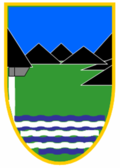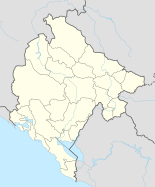Plav (Montenegro)
|
Plav Плав Plava / ë |
||||
|
||||
| Basic data | ||||
|---|---|---|---|---|
| State : |
|
|||
| Coordinates : | 42 ° 36 ' N , 19 ° 57' E | |||
| Height : | 945 m. i. J. | |||
| Area : | 486 km² | |||
| Residents : | 3,615 (2003) | |||
| Population density : | 7 inhabitants per km² | |||
| Telephone code : | (+382) 051 | |||
| License plate : | PL | |||
| Structure and administration | ||||
| Mayor : | Orhan Šahmanović ( DPS ) | |||
| Website : | ||||
Plav ( Cyrillic Плав , Albanian Plava or Plavë ) is a small town with about 3600 inhabitants in eastern Montenegro . The municipality (opština) Plav had 13,108 inhabitants according to the 2011 census.
geography
The city is located in the mountainous southeast of Montenegro in the wide valley of the Lim between the Visitor ( 2211 m. I. Year ) in the northwest and the foothills of the Prokletije Mountains in the east and south, which here in the Kofiljača still an altitude of 1825 m. i. J. achieved.
The center of Plav is around 945 m. i. J. on a hill between the eastern bank of the Plavsko jezero and the river Durička rijeka coming from the Prokletije .
The large municipality of Opština Plav was 486 square kilometers in size until 2014 and comprised the entire southeastern corner of the country between Albania's northern tip and the border with Kosovo . The western part of this area around the place Gusinje has since formed its own large municipality. There is a road connection from Gusinje to Vermosh in Albania. In the north-west, Plav borders on Opština Andrijevica , which, along with Gusinje, is the only place in Montenegro with a direct road connection. In the north lies the Opština Berane , in the east the Kosovar municipality Peć , whereby the border crossing there on the Čakorpass is currently closed (2014). In the southeast, the larger municipality borders on Albania.
Various places belong to the municipality, including Brezojevice .
population
In the city, which is only a few kilometers from the Albanian border, Muslims make up around two thirds of the population. There is also a significant Christian minority.
At the 2011 census, the municipality of Plav had 13,108 inhabitants (including Gusinje), of whom 6803 (51.9%) were Bosniaks , 2475 (18.88%) were Albanians , 2098 (16.01%) were Serbs , 822 ( 6.27%) described them as Montenegrins and 727 (5.55%) as ethnic Muslims. Other smaller population groups also live in the community.
history
Until 1912 and the Balkan Wars , the Sanjak Novi Pazar belonged to the Ottoman Empire . After Montenegro had raised territorial claims to Plav and Gusinje as a result of the Berlin Congress in 1878, Albanian troops of the League of Prizren occupied Gucia under the leadership of the local ruler Ali Pascha . In the Battle of Nokšić in December 1879 and January 1880, the Montenegrin army suffered two heavy defeats - also supported by Russian troops. The inhabitants of Gusinje were able to successfully prevent the area from being ceded to Montenegro until the collapse of the Ottoman Empire . Plav was finally assigned to Montenegro in the Peace of London in 1913 . A Swiss person described the place from his trip in 1914 as follows:
“The two towns of Gussinje in the west, with around 1500 inhabitants, and Plawa in the east, which had around 400 houses and around 2000 inhabitants before the war, are located in this vast basin. As a result of the new rule, many locals have emigrated, so that now only about 400–700 civilians remain (the information I have received varies ...), plus a battalion of infantry and a division of artillery, which are housed in a damaged Turkish barracks. ... A Serbian church in front of the city that was partially destroyed during the war proves that the population does not exclusively worship Islam. The city itself, on the other hand, has a completely Turkish character: guard houses at the entrance, terribly bumpy cobblestones, mosques and minarets, turbans and veiled women, wooden bazaars and the pretty country houses of some rich landowners. The Montenegrins have set up the telephone, as well as a small tavern, which serves as a meeting place for the military and travelers. There is currently no inn. "
tourism
The place is known for the lake, which is the basis for local tourism . At the lake there are beaches and some hotels for summer guests. Water sports can also be practiced on the lake .
Plav is the starting point for mountain tourism in the Montenegrin Prokletije and inquiries about the Prokletije National Park . The mountains are ideal for hiking. The Peaks of the Balkans long-distance hiking trail leads through Plav .
In the Plav area there is a partial risk of mines.
sons and daughters of the town
- Esad Mekulli (1916–1993), poet
Web links
Individual evidence
- ↑ Zakon o izmjenama i dopunama Zakona o teritorijalnoj organizaciji Crne Gore. (No longer available online.) In: Službeni List Crne Gore. March 7, 2014, archived from the original on September 26, 2014 ; Retrieved January 4, 2015 (Serbian). Info: The archive link was inserted automatically and has not yet been checked. Please check the original and archive link according to the instructions and then remove this notice.
- ^ Karl Kaser: Shepherds, Fighters, Tribal Heroes: Origins and Presence of the Balkan Patriarchate . Vienna 1992, ISBN 978-3-205-05545-7 .
- ^ C. Täuber: My crossing of the northern Albanian Alps in April 1914 . In: Yearbook of the Swiss Alpine Club , 50th year 1914 and 1915, Verlag des Schweizer Alpenclub, Bern 1916
- ↑ Travel advice for Montenegro. In: Federal Department of Foreign Affairs. November 20, 2014, accessed January 3, 2015 .



